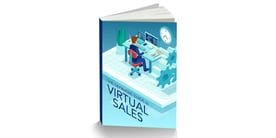Webinars have always been a cost-effective way to reach an audience at scale unlike more pricey options like dinner seminars. Now, with COVID-19 impacting our ability to meet with people in-person – they’ve become a necessity for financial professionals. But if you’ve held a webinar before and didn’t see as many conversions as you would’ve liked-- then stick with me and I’ll share how to use email to follow up after a webinar to help turn more attendees into qualified leads.

What happened—why didn’t I set more appointments?
After your webinar is over and you analyze your metrics to see how many appointments you set, you might have questions about what went “wrong” and wonder why you didn’t get as many as you hoped.
Was it your content? Did it fail to speak to the problem the attendees had?
Was the audience not in your target market?
Were you nervous during your presentation?
Was your call-to-action not compelling enough?
All good questions to explore and test variations in future webinars. But that’s not what we’ll be talking about in this post.
Instead, we’re going to cover how to get as many qualified leads as you can AFTER THE FACT. We don’t want all the hard work you put into the webinar to go to waste.
How to send the webinar follow-up email
It’s a good practice to notify registrants that someone may follow up with them after the webinar. If you aren’t aware of the rules for contacting via email, you can read more here.
You’ll want to send your first follow-up email within 24 hours and reiterate the highlights of your presentation. Take your list of attendees that did not book an appointment while on your webinar. This is who you want to follow up with now by email, which could be sent via the webinar platform. If you use an email service provider, such as MailChimp, that allows you to send mass emails, you might instead set up your own automated email sequence. And there's always the option to send your emails manually on a one-off basis.
Gathering feedback
Since you’re reaching out, now would be a great time to find out why they didn’t book a call right after the webinar. Although you probably won’t come out and ask that specifically—you’ll find out what they liked, didn’t like, wished they would’ve learned more about, etc.
In whatever online survey tool you use (example: Survey Monkey), you may have an option for multiple choice questions, which can be good information to collect. But what’s even better is asking open-ended questions. If you need to, add a comments section so that you can get longer answers with more details about their experience. This feedback will help you craft a better webinar next time and hopefully improve your conversion rate.
It’s good to do more than one webinar so that you can actually get a feel for what’s working and what’s not. A one-off webinar is not going to provide those answers. Creating effective webinars is an iterative process and one worth honing—especially if this is going to become the “new norm” of connecting and attracting clients.
The anatomy of an effective follow-up email
Go into writing the follow-up email assuming attendees wanted to book a call but needed time to think about it NOT that they hated everything you said and never want to hear from you again. In your email, you can send a link to the webinar recording and to be extra helpful, let them know the timestamps of the most critical pieces of info they might want to re-review.
Remind them of your call-to-action: booking an appointment with you. Provide the link to your online scheduler and ideally, create a sense of urgency for them to do this. Maybe you only have a few open time slots available since these are complimentary calls – be sure and let them know that.
The core message you want to get across in the follow up is why NOW is the best time to take action.
In your message, describe what it will be like to work with you after they make the decision to set up a call. This is called “future pacing.”
At this point, you’re only selling them on the idea of setting up a call – not necessarily working with you and your firm. That will come later IF you both decide it’s a good fit.
Next, you’ll talk about what life will be like if they choose NOT to set up a call. Will their life look exactly the same one year from today as it does now—with the same problems and concerns? And is that what they want? Probably not.
What might a follow-up email like this say?
Let’s assume hypothetically that you just gave a Social Security presentation because you’re highly qualified to speak on this subject. Here’s an example email you might send when you’ve reached out at least once or twice already, provided the replay link and gently encouraged them to set up their call. This is your last attempt to reach them, so it has to inspire them to take action:
Hi [Name],
I hope you’ve had a chance to watch the replay. Unfortunately, it doesn’t look like you’ve booked a call yet. After this I won’t continue reaching out regarding this webinar you attended, so I wanted to give you a quick recap of our relationship so far…
- You wanted to learn how to potentially get a higher payout from Social Security.
- You found me, and I promised to show you important steps on how you may be able to do that.
- You showed up for my webinar and I told you what to consider when it comes to getting a potential increase in Social Security payments and what to do next (book a complimentary call).
But now you’re at a crossroads.
Part of you wants to dive right in and see if I can help you get your financial life where you want it to be so you don’t have to worry about outliving your money.
But then there’s the other part telling you to accept things the way they are.
I’ll be honest, there’s a good reason we all have that part of ourselves (including me)…
To protect ourselves from failure. No one wants to invest time, energy and money into something to not see it work.
I’m not promising you a silver bullet.
But I will promise that if you book a call, I’ll show up 100% committed to understanding your specific situation and let you know if I think I can help. If I can’t, I’ll let you know that too.
But don’t wait any longer and let the opportunity disappear.
Go here to book a call.
And remember… you can always respond directly to this email and I’ll answer any lingering questions that are holding you back from scheduling a call with me. I’m here to help!
Keep in mind…
This is not intended to be some hard sell. You’re simply offering them an opportunity to speak with you one-on-one. The sole purpose of your follow up is to get them to take the next step—set an appointment. Incorporating these key elements into your email follow-up could help convert more webinar leads into prospects even after your webinar has ended.
Speaking of webinars, did you catch our most recent where Royal Fund's 2019 Advisor of the Year shared what's been working for him in welcoming and serving new clients even during this period of social distancing? It was jam-packed with helpful training. Click below to get the replay.






